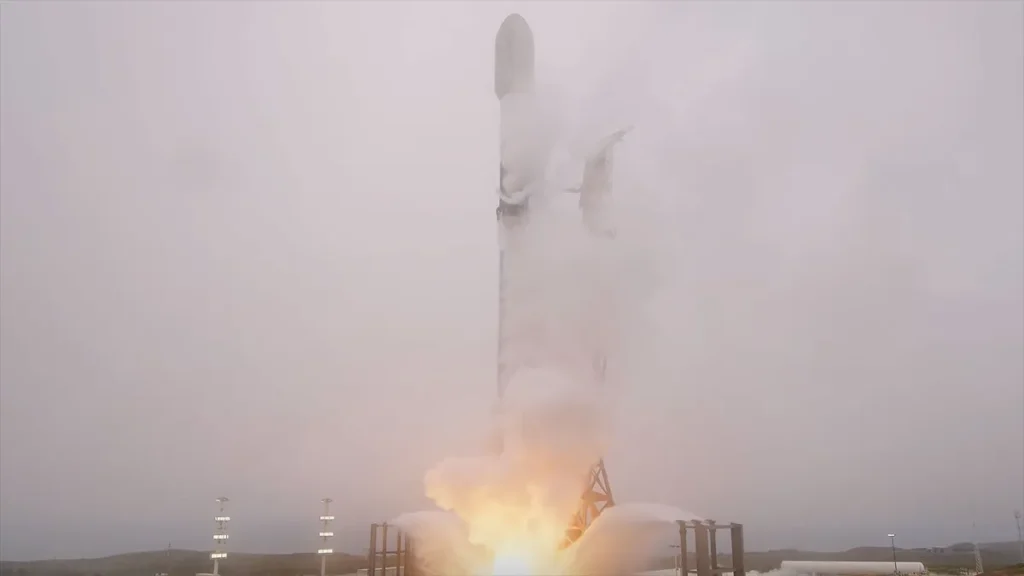
SpaceX Falcon 9 lifting off with Transporter-14 mission on June 2025. Credit: SpaceX via Space.com
Discover what SpaceX launched in the Transporter-14 mission — including human ashes in space, Varda’s reentry capsule, climate satellites, CubeSats, and more. A full deep dive into Falcon 9’s shocking and emotional rideshare payloads. Transporter-14, SpaceX rideshare mission, human ashes in space, Falcon 9 launch, Celestis memorial flight, space burial, Varda capsule, reentry payloads, climate satellites, student CubeSats
Introduction: A Rocket That Carried Memories
On June 12, 2025, something extraordinary happened in the sky above Vandenberg Space Force Base. While the world looked up to watch another SpaceX Falcon 9 roar into the sky, few realized that this rocket carried more than just science — it carried emotion, hope, remembrance, and the future of humanity.
SpaceX’s Transporter-14 rideshare mission wasn’t just another launch. It included over 36 payloads from around the globe. Among them? Human remains, reentry experiments, Earth-monitoring satellites, and student projects that inspire a new generation.
In this blog, we go deep into the 5 most shocking and meaningful payloads aboard Transporter-14. This isn’t just news. It’s history in motion.
1. Human Ashes in Space: Celestis Memorial Flight on Transporter-14
The most heart-touching payload aboard Transporter-14 was carried by Celestis Memorial Spaceflight – a service that sends cremated human remains into space.
This was not the first time Celestis partnered with SpaceX, but it was one of the most emotional. Dozens of space urns, carrying the ashes of loved ones, were launched into orbit to become a lasting tribute among the stars.
These remains will orbit the Earth for years. Eventually, they will burn up in the atmosphere, becoming what many describe as a “shooting star farewell.”
“It’s a symbolic way to give our loved ones the ultimate cosmic resting place,” said one family member.
The concept of space burial is not new, but with Transporter-14, it became more personal, more visible, and deeply human.
human ashes in space, Celestis memorial flight, space burial
2. Varda Capsule on Transporter-14: Reentry Payload and Space Manufacturing Future
One of the most exciting and futuristic payloads was the Varda Space Industries‘ capsule.
Designed to conduct manufacturing in microgravity and then reenter Earth’s atmosphere, this test proved that space factories aren’t just science fiction anymore.
This capsule was packed with experiments on crystal growth and advanced pharmaceuticals – materials that form differently and more purely in zero gravity. Once completed, Varda’s capsule was planned to return to Earth, showcasing the potential of space-based production systems.
If successful, this opens the door to a $1 trillion orbital manufacturing economy.
Keyword Use: Varda capsule, reentry payloads, space-based manufacturing
3. Climate Satellites Launched on Transporter-14: SpaceX Falcon 9 Watching Earth from Orbit
Another payload group aboard Transporter-14 was a fleet of Earth-imaging satellites from multiple international organizations.
They were tasked with monitoring:
- Greenhouse gas emissions
- Forest cover changes
- Ocean temperatures
- Urban heat islands
Companies like Planet Labs and Satlantis contributed payloads designed to give real-time data for scientists studying the climate crisis.
In a world facing extreme weather events and rising temperatures, these satellites serve as our planet’s eyes in orbit.
“You can’t solve what you can’t measure.”
climate satellites, Earth-monitoring payload, greenhouse gas tracking
4. AI-Powered Star Trackers: The Smart Navigator of Space
Among the high-tech experiments onboard was an AI-powered star tracker system from a European space tech company. This system helps spacecraft determine their exact orientation and location by identifying star patterns in space.
Unlike traditional systems, this star tracker uses machine learning to improve its accuracy and adjust in real time. It’s a major step forward for autonomous navigation in space.
These trackers are ideal for future Mars missions, deep-space CubeSats, and interplanetary probes.
: star tracker, autonomous spacecraft navigation, AI in space
5. Student CubeSats: The Future of Space Begins in Classrooms
The most heartwarming payloads came from students.
Three student-built CubeSats from India, Poland, and Japan were among the payloads. These small satellites were designed by high school and college students as part of STEM programs encouraging space science education.
Their goals included:
- Earth observation
- Radio communication tests
- Thermal mapping
Each of these CubeSats represents hope, innovation, and global collaboration.
“Our satellite is small, but our dream is big,” said a student from India.
Keyword Use: student CubeSats, space education, international space collaboration
Top 5 Shocking Payloads Aboard Transporter-14
| Payload Type | Purpose | Country/Organization |
|---|---|---|
| Human Ashes | Space memorial | Celestis (USA) |
| Varda Capsule | Orbital manufacturing + reentry test | Varda Space Industries |
| Climate Satellites | Earth monitoring for climate change | Planet Labs, Satlantis |
| AI Star Tracker | Smart spacecraft navigation | European Tech Startup |
| Student CubeSats | Education, tech demos | India, Poland, Japan |
Why Transporter-14 Matters More Than Just Numbers
While it may be the 14th rideshare under SpaceX’s banner, Transporter-14 stands out because it represents humanity in orbit:
- Love (human remains)
- Future economy (Varda)
- Responsibility (climate satellites)
- Intelligence (AI navigation)
- Hope (student CubeSats)
This mission showed us that space is no longer just for astronauts or billionaires. It’s now about memories, science, collaboration, and legacy.
And as SpaceX continues its rapid pace of launches, each flight becomes a chapter in how Earth reaches out to the stars.
✉️ Final Thoughts: The Sky Is Not the Limit
Transporter-14 wasn’t just a ride to orbit. It was a journey of stories — personal, scientific, and historic.
Whether you’re inspired by the concept of space burials, amazed by space factories, or hopeful about student space projects, this mission gave something to everyone.
This wasn’t just a launch. It was a statement: Space is for all of us.
→ Read next: VIPER vs PRIME-1: NASA’s Moon Ice Hunt Missions Compared
